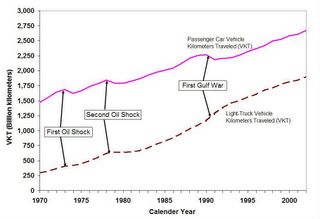As I have
noted previously, Canada has been working with the auto companies to set greenhouse gas emission reduction targets. Today
Green Car Congress reported that the
agreement has now been made public.
This agreement calls on the automobile industry to cut GHG emissions from light-duty vehicles (cars, minivans, sport utility vehicles and pickup trucks) so that by 2010, annual emissions reductions will reach 5.3 Mt.
The 5.3-Mt target is measured from a "reference case" that projects business-as-usual vehicle emissions in 2010 and that has been agreed upon by industry and government. To assess progress toward meeting the 5.3-Mt target, a joint industry-government monitoring committee will be established. Annual reports from the committee will be available to the public.
The MOU states that "The Reference Case greenhouse gas emissions for the light duty vehicle sector in 2010 are 90.51 Mt of CO2e" as stated in
Canada's Emission Outlook (Annex C Page 26).
Greenhouse gas emissions from light-duty vehicles are already about 95 Mt due to the growth in the light-duty truck segment. So, the actual baseline number in 2010 is going to be much larger. So, I am not sure how this is going to be worked out. It can be safely assumed that the language in these MOUs is formulated rather loosely so that actual committee working on this may decide the actual details and the best possible ways for the Auto companies to reach their goal.
Let us put the 5.3 Megaton in perspective. The vehicle sales in Canada are about 1.5 million vehicles per year. I am assuming that they are driven much like the American light-duty vehicles (~11000 miles per year or 17600 km per year). If the average fuel economy of the current vehicles is about 25 miles per gallon (~ 220 grams of CO2 per km), then the emissions from new vehicle sales in one year are about (1.5 million * 17600 * 220) grams or 5.8 trillion grams or 5.8 Megatons of CO2. Think of 5 such years between 2005 and 2010, so the total additional emissions will be of the order of 5.8*5 = 29 Megatons. A 5.3 Megaton reduction means roughly a 20% reduction in greenhouse gas emissions or roughly 25% increase in fuel economy. (Note these are rough estimates, but they should be in the ballpark).
This, I think that this deal is a big thing. This agreement has other implications:
One, it shows that *some* agreement can be reached over reducing CO2 emissions from light-duty vehicles.
ACEA in Europe started this trend (
caution:pdf file). Now, the US needs to decide what it is going to do.
Two, my guess is that the Auto industry would rather not deal separately with California's AB 1493, US Northeast, Canadian MOU and the US CAFE standards. This means that there is now a significant chance of different parties coming together to talk about this issue seriously. This is a significant opportunity, and it will be a shame to squander it.
There is a lot to discuss here, but more thoughts later.




